For today’s post one thing led to another. And another. And another…
- If you’re on a mobile device (small screen) the major point I’m attempting to make with this post might be less apparent to you but if you’re not a photographer it may not matter.
It all started yesterday morning with my frustration with hummingbirds.
I’ve had my hummingbird feeder up for more than two weeks now and they’re being seen in the Salt Lake Valley but I’ve yet to see one at my feeder. I hoped I might have just missed seeing the relatively few that show up here this early but I worked in the vegetable garden for most of the day yesterday figuring I’d see at least one.
Nada, zilch – didn’t happen.
So late yesterday afternoon when I sat down at my computer to make the final decision for today’s post I looked at some of my older hummingbird photos just to scratch my hummer itch and came across this one.
But the chain of events didn’t stop there. It was only the beginning. Of the beginning.
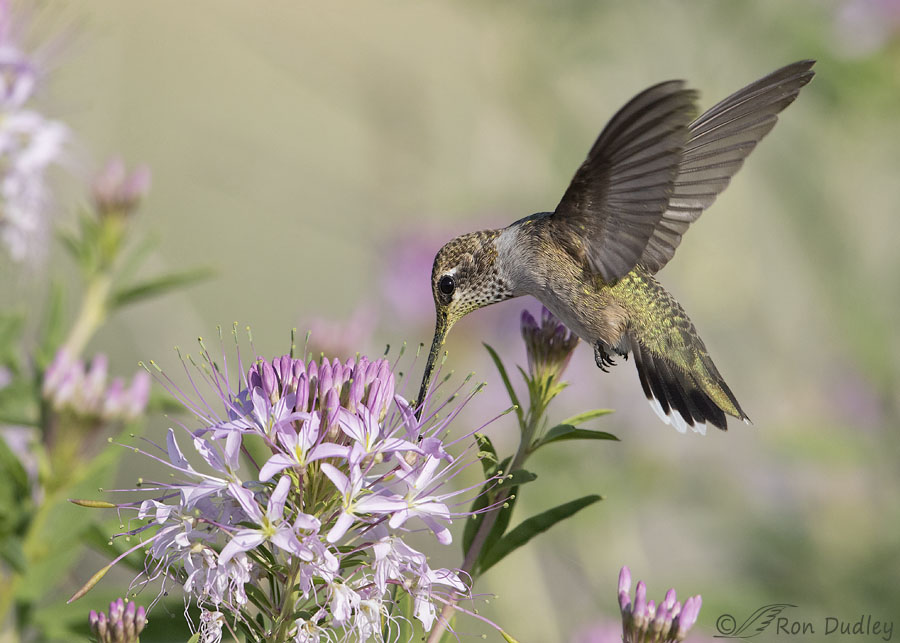
1/4000, f/6.3, ISO 800, Canon 7D Mark II, Canon EF 500mm f/4L IS II USM + EF 1.4 III Extender, not baited, set up or called in
The photo, taken on Antelope Island on August 18, 2017 as the Black-chinned Hummingbird was feeding on Rocky Mountain Bee Plant (cleome), was one of the first hummer shots I looked at last night. I’d never posted it before, probably because the body of the bird is turned slightly away from me and there’s a flower stem sticking up into its breast. Silly me.
I like it quite a lot but the bird isn’t particularly large in the uncropped frame (this version has been cropped significantly) and I didn’t know how it would hold up to a fairly large crop so I did some pixel-peeping to check it for critical sharpness.
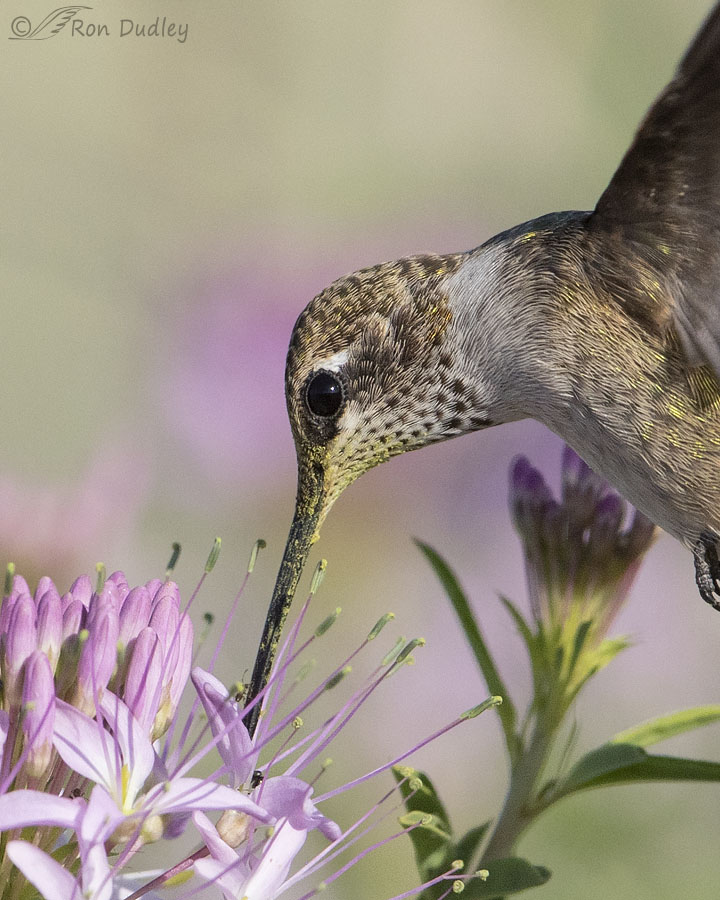
The bird was tack sharp so I needn’t have worried about significant cropping (cropping only makes softness worse.) This version is cropped to only 10% of the original image (2 MP of the original 20 MP.)
Normally at this point I’d just process the image, post it and be done with it but at this higher magnification I noticed what appeared to be two ants near the end of the bill and I wanted an even closer look at them.
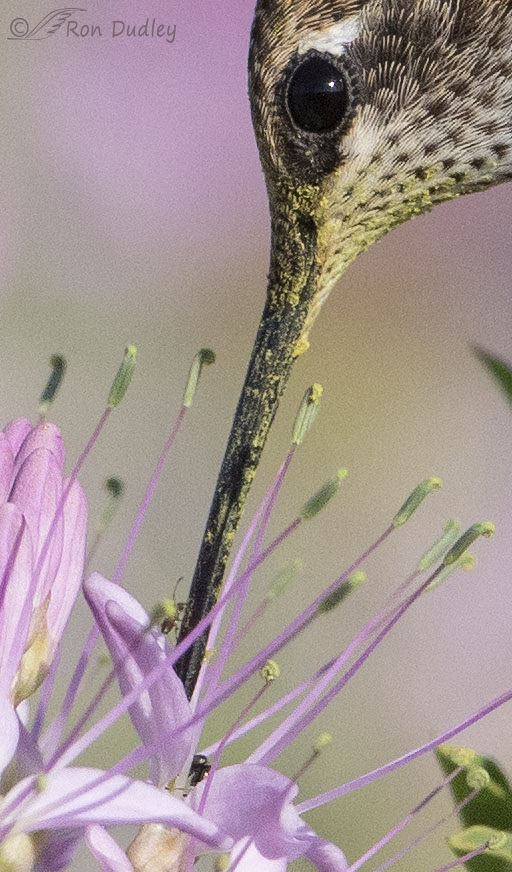
So I cropped some more, this time to only 5% of the original. Yup, looks like two ants to me – a teeny, tiny one about to crawl onto the hummer’s bill and a larger one further down on the flower.
Every time I cropped more I was impressed by the sharpness and detail that remained.The individual feather barbs on the face are clear and sharp and we can even see individual pollen grains on the bill. Many hundreds of them.
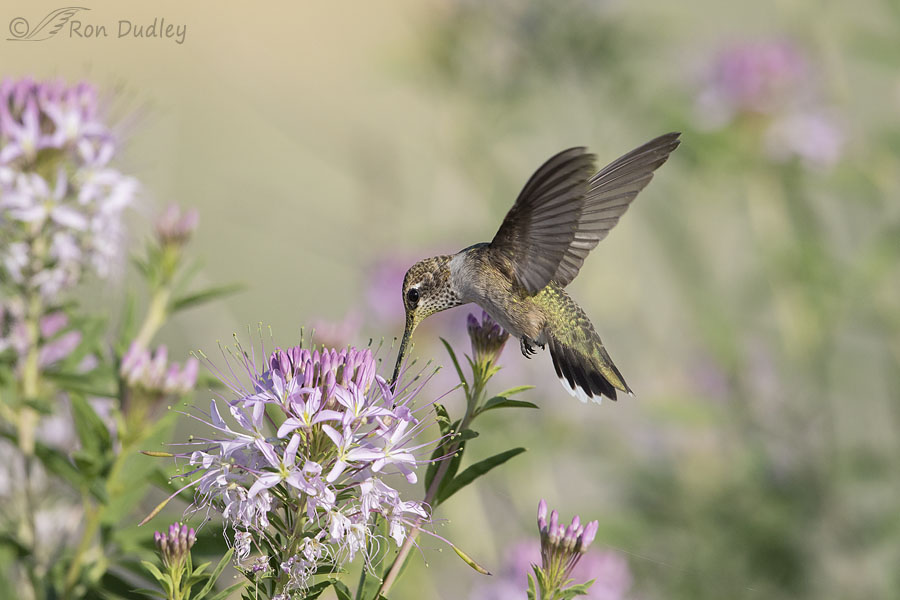
At this point I realized that if I posted the image readers still didn’t have a clear visual impression of how much I’d cropped so I decided to process a version of the photo that was full frame, uncropped. This is it.
And then I realized I still wasn’t done. Some readers might want to know where in the image my active focus point was when I took the shot. After all, that little detail is largely responsible for the sharpness of the bird.
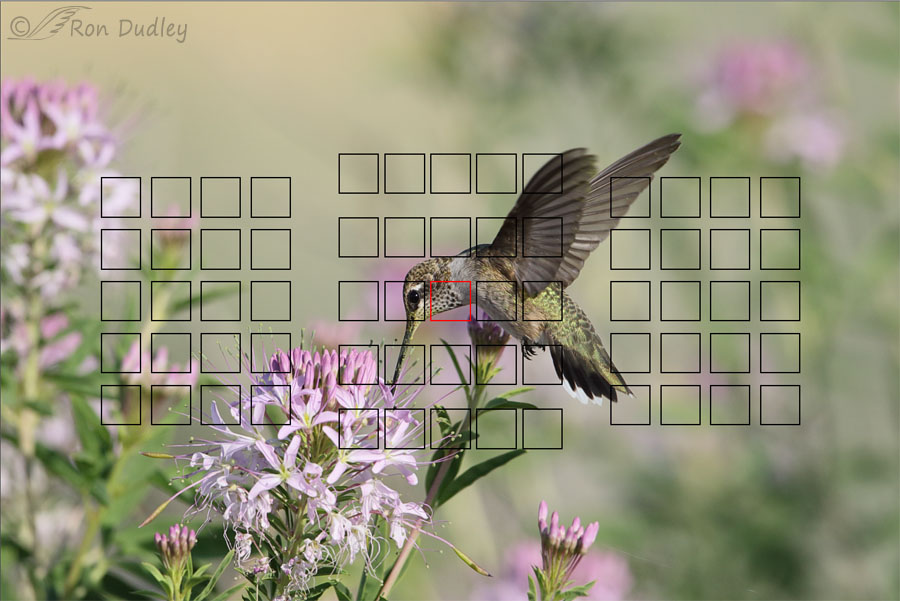
That meant processing yet another version of the photo – this time using Canon’s Digital Photo Professional to produce a full frame version showing inactive focus points (black) and my single active focus point (red) when I took the shot.
So there you have it – five versions of the same image but I hope I’ve made my point. If the subject is truly sharp significant cropping can hold up unusually well.
And I must say, once again I’m impressed by an image taken by my Canon 7D Mark II. If you ask me it’s pretty damn good for a photo of a bird in flight taken with a 20 MP camera and a focusing system that is now 6 years old. Of course my high quality lens was a major player too.
Ron
Notes:
- Some readers might wonder if I used noise reduction during processing with any of the versions of this photo. I didn’t. And yes, there’s significant noise in the largest crops but that’s to be expected, especially with a 20 MP photo taken at ISO 800 and then drastically cropped.
- Now you know why some of my posts are published a little late. When I get on a roll and then one thing leads to another it’s almost impossible to plan ahead and alot the required amount of time.


Gorgeous photo, no question about that.
But would you clear something up for me? When you say cropped, are you also resizing the photo, or are you just discarding parts of the image you don’t want, i.e., cropping at 100%?
Also, you showed the focus matrix on your camera but didn’t mention the focus method. Were you using single-spot focus or the grid? I’m guessing single-spot but you didn’t explicitly say that.
I just now subscribed to your blog so I’ll be an interested reader going forward. I just started bird photography last fall and it’s taken over my life, so to speak. I enjoy seeing birds in the forests, of course, but I enjoy post-processing my images in Photoshop almost as much.
Thanks for your time.
Thanks, Dave. And welcome to Feathered Photography.
1. I crop my images and then resize them.
2. I was using single point AF.
Thank you for the demo-incredible detail and sharpness.
I’m glad you enjoyed it, Jane.
Couldn’t be better!!!👍👏❤️
Thanks, Patty.
Ron, its really nice when it all comes together in one photo isn’t it. I saw my first hummingbird today in our yard enjoying some of the spring flowers, but unfortunately it was just far enough away that I couldn’t ID it. Anyway, nice post again.
“its really nice when it all comes together in one photo isn’t it”
It sure is, David. I wish it happened even more often… 🙂
Outstanding article, Ron. As a photographer who shoots hummingbirds almost exclusively, and as one with the lofty ambition of photographing every hummingbird species, I go through these processing gymnastics all the time. You made me laugh with the statement that you never posted this before because of the bird’s position and the flower stem. I thought I was the only one who obsesses over minor imperfections!
Thanks, Carole. “Processing gymnastics” indeed.
Nope, you’re not the only one. Folks accuse me of excessive nitpicking of my own images all the time. I think I’ve become a little numb to it… 🙂
Wow! The detail in those closeups are amazing — SO sharp! Very cool to see the progression of the crops too. WOW!
Thanks on both counts, Marty.
An elucidating post and comments, to say the least. Beautiful uncropped, astounding detail in the cropped ones.
As with Dan Gleason, we only have the Anna’s and Rufous in NW Washington. The Anna’s year-round, the Rufous for several weeks now.
Given the discussion of mites, I am wondering why a male Rufous takes baths sitting on a rock at the top of my artificial waterfall several times a day. If not for mites, what? Lice? Cobwebs, pollen, etc.? For fun?
Thanks, Lyle.
Because they can?
Hummers are yet another bird you get and we don’t. I am envious. And, as always, I am blown away by the shot and hugely grateful to you and to your knowledgeable commentators.
Thank you, one and all.
And yes, when my mind gets the bit between its teeth, it is useless trying to rein it in.
“Hummers are yet another bird you get and we don’t”
It’s nice to know we have at least a few like that, EC. I don’t think anywhere else on earth has more bird and wildlife diversity than you folks in Oz.
Grateful as I am for our wildlife (including the birds) there are a lot of other places which cause my greedy eyes to go green. The list of birds/animals I would love to see for myself is long, and growing.
I found it all interesting!
Good. Thanks, April.
Wow, the ants! And Dan & Barbara’s explanation of the taxi/Lyft service hummers provide for mites! (Since I live very near the SoCal coast, I’m sure my hummers have been providing this service unbeknownst to me all these years.)
But the image—specifically the original version—really takes my breath away. Gorgeous background colors to highlight the foreground colors and the lovely little bird. Thank you for all the effort to show us what we may very well have missed otherwise. Hope you get to see some hummers in your yard soon!
Chris, — As I understand it, the hummingbird mites in So. Cal live in a particular species of indian paintbrush, but I don’t know which species. More species of flowers, mites and hummingbirds are involved from Mexico south,
Ah, thanks, Dan. I don’t have any paintbrush in my yard, and of course, Allen’s & Anna’s predominate here (Ventura Co.) … still, I love the whole idea of a hummingbird taxi service!
Chris, whenever Dan chimes in I always sit up and take notice.
Still no hummers so far today. I’m beginning to feel slighted… 🙂
Great demonstration of sharpness and cropping, Ron! My policy is to never to export anything from Lightroom smaller than 2048 pixels on the longest side and so that’s also my minimum cropped size, since that becomes 1:1 pixels. It’s just a personal standard that has served me pretty well. It looks great on the web and prints very well to at least 8×12. Of couse, like any photographer, I would always prefer more pixels, but that’s my minimum standard.
David, Unless I’m just posting a documentary or educational photo I start getting nervous with anything below 3000 pixels on the long side. It’s just sort of a self-set boundary that I’ve become used to.
Superb post! I totally empathize with the “one thing leading to another” syndrome.
Fascinating study in image quality, Ron. The quality of the equipment is certainly a factor, but without an operator who knows how to take advantage of that equipment – well, good gear can take soft shots all day. I should know!
Impressive field of view focus clarity at f/6.3.
Thank you for another tutorial!
“good gear can take soft shots all day. I should know”
Ha, I know it too, Wally. Especially in winter when heat waves disturb the air and make shot after shot miserably soft. That may contribute to why I have so little hair!
Ron,
Exceptional photographic quality. I am always impressed as you say: when they are sharp, they are sharp. That is always the goal and a goal I struggle with. I am also impressed with the quality you get with a 20 mp sensor at ISO 800. Again, as I have said before, you are my bird mentor and I compare my quality to yours, and when I have good light and a fast shutter speed (as in most of your shots) the noise is less than a high ISO shot to make up for bad light. However, it is hard to pick and choose the days to go out when still employed. Thanks for your posts.
Stephen
Also, BTW, we have had a couple of hummers at our feeders for the last week or so. Great fun. Summer is here… almost.
Stephen
We all struggle with sharpness, Stephen. I get at least my share of soft shots, partly because I take so many photos of action and behaviors. But as you say when they’re truly sharp they really catch your eye, especially when you pixel-peep.
WOW! Just WOW! (Insert all my ridiculously redundant comments here!) You even stopped the wing motion. Is that even possible?
Laura, I think the wings are as sharp as they are because I caught them at the top of their beat cycle. Otherwise I often need slightly faster shutter speeds to “freeze” them.
Great photos. Black-chinned Hummingbirds occur in the mountains but here in the Willamette they are only a rare migrant. Our two species are Rufous and Anna;s. Rufous arrive here in February and head to the mountains by mid-summer to feed on the nectar of wildflowers, doubling their weight before heading south. The Anna’s hummingbird is here all year. It’s nice, but still seem strange, to have a hummer coming to the feeder when temperatures are in the 20s or lower. Very tough little guys.
Barbara alluded to hummingbird mites. They are mostly tropical although at least one species occurs on the southern California coast. They live in flowers and are so tiny they are unable to get to a fresh flower when their home is starting to shsrivel. So, when a hummingbird pokes its beak in the flower, the mites rush onto the beak and run up into the hummer’s nostrils. When the bird probes the right kind of flower, the mite sense this and leave the nostrils to embed themselves deep in the flower. They do no harm to the bird who reacts as though it is totally unaware of them. The hummingbird is just the taxi service. Nature is full of marvelous things if we look hard enough.
You’ve described some incredibly interesting natural history, Dan. It was new to me and I’m fascinated by it. Thank you.
Ron, when you a processing a photo and zooming in, and you see sothing similar to ants on the bill of this hummingbird, I would love to see you post that image. There is so much in this world that we don’t see because it is so small. My brother sends me pics that he takes in the Ozarks. In many of the the flower shots, one can see the front arms of a crab spider sticking out from behind the flower. Or perhaps a mite on the head of an insect. The little stuff is so remarkable. I was very impressed with the detail of this photo as you zoomed in.
Brad, sounds like you have the same intense curiosity about those usually unseen little details as I do. Perhaps I’ll try to post stuff like that more often.
I’ll go for that anytime! 🙂
What a wonderful portrait and lesson, too! The overall composition is so lovely, the bird SO sharp!
I bet husband, Dan Gleason, will weigh in later, too! He often tells people about Hummingbird mites. Seeing the ants on/near the bird’s bill, made me think of the mites, who travel from flower to flower using hummingbirds as Lyft drivers… wonder if the bird was intending to eat the ants and they escaped being lunch by climbing aboard?
Thanks, Barbara. I look forward to Dan’s contribution. I always do.
Beautiful pictures and very interesting commentary. The hummers are my favorite bird and I’ve only seen three at my feeder.
Three is three more than I’ve seen at mine, Betty. Though I did see and hear a few in the mountains this morning.
Great photo and interesting and educational processing information. Thank Ron.
Thanks, Everett.
Well, as always, the early morning combo of beauty and photographic instruction is appreciated.
Good. Thanks, Dan.
Holy Cow, Ron! This single photo is amazing and so interesting. Although I am sad that you can’t be out in the field as much as you would like part of me is glad that you are exploring photos taken years ago. What treasures you have uncovered. The exquisite detail of this hummer’s eye, facial feathers and bill with the pollen and ant is amazing. Thank you for finding this gem and enlarging it. Your art is a gift to your followers.
I’m delighted to know you like it that much, Melanie. Every once in a while I do find some treasures when I go rummaging around…
Love my 7D Mark II and prefer it over my 5D IV for sports, birds, wildlife, really anything moving. Thanks for doing what you do Ron. I read your posts and enjoy your images daily. Lessons you’ve taught have helped me improve my game.
That’s wonderful to know, Garrett.
I love my 7D II also, both of them. I think it was just about the perfect camera for what it was intended for when it first came out and it’s still very good, even with the advancements that have been made since.
Not to say I don’t lust after some of those advancements… 🙂
Fantastic photo and photo lesson. I am in awe of this picture!
Thank you, Joanne.
One thing certainly DID lead to another! 🙂 Wonderful shot/crop/tutorial! 🙂 Cousin in ID is also waiting for hummer tho some a few miles away have them…….;) Fascinating birds! We only get a couple in the fall on their way back south tho guess they’re more plentiful towards the Highwood Mtns.
Thanks, Judy. I don’t remember ever seeing hummers on the MT farm but that’s not surprising. Not much nectar in wheat and barley. Or summer fallow.
THAT’S for sure! 🙂
I think that you have convinced yourself that a change in camera body although yearned for is not necessary. Save the money !!
Gary, I’d still like the much improved focusing abilities of the 1 DX Mark III but given the uncertainty of the times I’m just not prepared to spend that much cash on a new camera right now.
Another reason for my hesitancy is that the Mark III is full frame and still only 20 MP. I think Canon really screwed up with that combo.